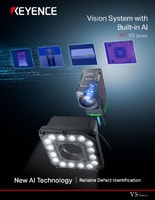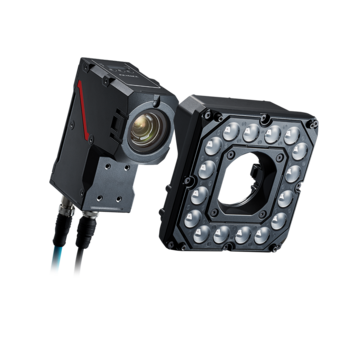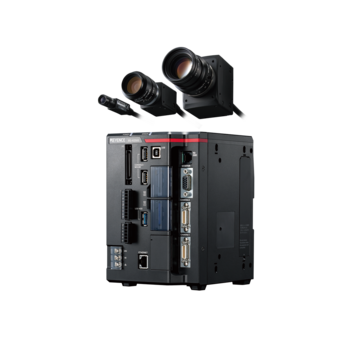Vision Systems
- Vision System with Built-in AI VS series
- Intuitive Vision System CV-X series
- Customizable Vision System XG-X series
- GigE camera and lighting for PC-based machine vision VJ series
- Inline 3D Inspection 3D Vision series
- 3D Vision-Guided Robotics 3D VGR series
- Line Scan Technology Line Scan series
- 2D Vision-Guided Robotics 2D VGR series
- LED Lighting CA-D series
- Lenses (for Machine Vision) CA-L series
- Machine Vision System Database VisionDatabase series
- Automotive
- Automation Equipment/Machine Building
- Electric Vehicles
- Medical Device Manufacturing
- Food/Beverage Packaging
- Semiconductor/Manufacturing Electronics
- Vision-Guided Robotics
- Solar
- Logistics
- Commodities
- Paper Manufacturing
- Machine Tools
- Electronic Device
- Printing
- Mining/Metals
- Fabric/Textile
- Tobacco
- Marine
- Aerospace
Transforming Warehouses: The Power of Machine Vision in Automated Logistics
Key Takeaways
- Machine vision replaces manual checks to deliver real-time inventory visibility and fewer picking errors.
- Vision-guided systems increase throughput and enable automation of picking, sorting, and AGVs.
- Image-based verification creates traceable records that reduce returns, recalls, and compliance risk.
- Upfront investment pays back fast: typical ROI 2–5 years; local upgrades can pay within 18 months.
- AI and vision reduces labor costs, cuts errors up to 70%, and lowers downtime through predictive maintenance.

If the worldwide pandemic of 2020 revealed anything, it's that supply chains aren't as robust as they seem, and plenty of organizations don't know where their goods are when an unexpected event takes place.
This is particularly true at the level of pallets, shipping containers, and trucks, which lack adequate visibility and real-time tracking information. However, warehouses, fulfillment, and last-mile centers also suffer from logistics issues despite having the best visibility in the supply chain in general.
The main issues stem from widespread labor shortages and a lack of warehouse space, prompting many businesses to push for more productivity from the same headcount and within the same space. This causes ineffective processes to break down faster, which in turn produces downtime or other financial losses.
A decade ago, most warehouses relied on clipboards and manual checks. Now, order volumes have multiplied, but the old methods haven’t kept up. Machine vision is part of the new wave of automated logistics systems, replacing handwritten counts with real-time visibility at an industrial scale.
Logistics Challenges & Trends
Warehouses face tight margins, increasing order volumes, and difficulties with hiring skilled labor. Manual processes often slow fulfillment, create errors, and increase costs, and, at the same time, logistics leaders are seeking better inventory accuracy and end-to-end transparency. These challenges have accelerated the adoption of warehouse automation systems, with machine vision now critical to making them smarter and more adaptable.
We’re here to provide you with more details.
Reach out today!

Benefits of Machine Vision Automation in Logistics
Machine vision adds perception to warehouse automation technology by allowing systems to interpret what moves across a line in real time. Cameras scan barcodes, labels, and product details at production speed, converting visual data into decisions that keep operations moving. Its impact shows up in several ways:
- Higher order accuracy: Shipments match customer requests with fewer errors.
- Reduced picking mistakes: Mis-scans and misplaced items are caught before they move downstream.
- Faster throughput: Packages flow across conveyors and sorting points without bottlenecks.
- Safer operations: Automated checks reduce the need for manual handling in high-volume areas.
- Traceable records: Images and data logs create a digital trail that supports compliance and audits.
Here are some of the most significant benefits of machine vision systems in logistics automation:
Accuracy and Reliability
Machine learning implementations in vision technology ensure object and defect detection in logistics automation, but with machine-like precision, which provides more consistent results. Since these systems aren't as prone to errors as human operators, machine vision automation significantly decreases the risk of any inventory management errors by streamlining the identification, sorting, and traceability of goods.
Efficiency and Speed
Machine vision systems for logistics automation don't relate to reading barcodes, QR codes, lot numbers, and other code data alone. Machine vision streamlines logistics operations across the board, from automating picking and sorting robots to faster quality control checks. This real-time analysis and process optimization enables immediate decision-making that keeps the logistics operations moving swiftly and smoothly at every point in the supply chain.
Cost Savings
Increased accuracy and reliability have advantages of their own. By minimizing errors associated with handling goods, vision systems also reduce the costs associated with returns, rework, and customer dissatisfaction. Furthermore, automation is much more efficient compared to human operators. While it incurs sizable one-time payments, it reduces the need for manual labor, leading to significant cost savings in terms of employee training and unexpected turnover.
Safety and Compliance
Machine vision systems in logistics automation monitor compliance with various safety standards and protocols while also taking over hazardous and physically demanding tasks. This leads to a decreased risk associated with workplace accidents, enhancing the overall safety of the logistics environment.
Overall Increased Efficiency
Automation in logistics also guides numerous processes besides mere inspection. They identify and inspect received goods, aid in labeling, sorting, and palletizing products, help optimize warehouse layout, monitor inventory levels, and track the locations of goods. Machine vision identifies and retrieves goods, which are then prepared for delivery.
Discover more about this product.
Click here to book your demo.

Applications of Automated Logistics Solutions
Logistics and warehouses typically run mostly on barcodes due to the coding method's universality. Nearly all information can be encoded using 2D barcodes, and the more these codes are scanned within the supply chain, the better the visibility.
Though the industry was previously dominated by human operators with handheld barcode scanners, a switch to machine vision directly addresses labor shortage and efficiency issues while also providing more opportunities for further verification and decision-making.
However, modern machine vision systems, such as KEYENCE's XG-X Series, excel at object recognition. These systems can acquire accurate product dimensions, detect damage or defects, flag missing products, and even optimize warehouse storage space.
Automated warehousing implies an automated sorting system, which means goods are properly packaged and labeled before the automated system sorts them according to size, shape, and subsequent delivery.
The applications of automated logistics solutions extend beyond mere barcode readers and warehouse automation. They also verify shipments against purchase orders, update inventory levels, and streamline the overall receiving process.
Automated Sorting & Verification
A conveyor can’t stop every time a label is smudged. Vision systems read thousands of barcodes and QR codes per hour, even when they’re skewed or faded, and direct each box without breaking the flow.
Inventory Management
Cycle counts that once took hours now happen in the background as machine vision tracks pallets and bins in real time, so stock levels stay accurate without pulling staff off the floor.
Vision-Guided Robotics & AGVs
Robotic arms don’t just need strength; they need sight. Machine vision helps them grip the right part, while AGVs use cameras to navigate tight aisles and avoid collisions.
Quality & Safety Inspection
A dented carton or a missing seal can slip through when lines move too fast for human eyes. Vision systems catch those flaws in real time, pulling defective items before they leave the floor. The result is fewer recalls and fewer customer complaints.
Space Optimization
Warehouses often run out of floor space long before they run out of height. Vision-guided storage makes it possible to rack goods higher and still retrieve them quickly.
Case Studies: Machine Vision Success Stories
Both large e-commerce operations and food producers are applying warehouse automation systems with vision at their core.
E-Commerce Fulfillment (Amazon)
Large-scale fulfillment centers, like Amazon, use vision to accelerate throughput. In one deployment, image-based positioning increased picking cycles by 15%, while vision-enabled barcode readers reduced mis-ships. These tools keep pace with high SKU counts and customer demand for rapid delivery.
Food & Beverage Packaging (Fairlife Dairy)
In dairy packaging, vision systems identify defects such as missing lids or illegible codes in real time. Automated cameras withstand washdowns, capture data on recurring issues, and provide 100% traceability. The result is consistent quality without slowing production.
Curious about our pricing?
Click here to find out more.

ROI and Business Impact
Rapid ROI
Payback doesn’t take long. In many warehouses, vision upgrades recover their cost in just two to five years, and smaller steps, like adding image checks to picking, often pay off inside 18 months.
Labor & Error Cost Reduction
With labor accounting for up to 65% of warehouse operating costs, automation reduces reliance on repetitive manual tasks. Vision-guided systems cut errors by up to 70%, lowering rework and return costs.
Investment Horizon
The warehouse automation systems market is on a sharp climb, expected to top $50 billion by 2030. Adoption is accelerating (more than half of warehouses are projected to use automation by 2027), which makes waiting a risky move.
Productivity Gains
Throughput can double or even triple when robotics and warehouse automation technology work together. Add predictive maintenance to the mix, and downtime drops by as much as a third. For operators, that means more orders out the door without adding shifts or expanding floor space.
Streamlining Operations with Automation in Logistics
Logistics automation relies on technology-driven automated systems that optimize various processes associated with the logistics industry. It incorporates many different advanced technologies, such as artificial intelligence, machine vision, robotics, and others. As such, it also inherits many advantages offered by said technologies.
This includes relying on visual sensors, such as the VS Series, to perform a visual analysis of each logistics process, ranging from reception and quality inspection, storage preparation, labeling, sorting, and storage to retrieval for order fulfillment and subsequent delivery to the end consumer.
By streamlining these operations, logistics automation minimizes the risk of error, positively affecting customer satisfaction and business growth while cutting operational costs.
Contact us to learn more about how our advanced technology can help take your business to the next level.
Contact Us
FAQs
What is Logistics Automation, and How Is It Implemented in the Industry?
Logistics automation refers to implementing automated systems powered by artificial intelligence, machine learning, robotics, and other technologies to optimize various processes associated with the logistics industry.
The implementation is carried out by integrating automation technologies and equipment that rely on machine vision systems and data analytics for quality control, item tracking, and enhanced accuracy regarding verification and handling of goods.
What is an Automated Logistics System?
It is a network of technologies, including robotics, conveyors, storage systems, and machine vision, that streamlines warehouse processes from receiving to fulfillment.
How Does Machine Vision Improve Warehouse Efficiency?
By capturing and analyzing images at speed, machine vision reduces errors, accelerates sorting, and provides data that keeps operations running smoothly.
What Industries Benefit From Logistics Automation Technology?
E-commerce, food and beverage, pharmaceuticals, and manufacturing all rely on warehouse automation systems to meet growing customer and regulatory demands.
How Does Machine Vision Automation Contribute to Improved Efficiency in Logistics Processes?
Machine vision systems improve the efficiency of logistics operations by increasing the processing speed of automated tasks, such as sorting, scanning, and quality inspections, and provide higher accuracy in tracking and inventory management. This leads to an overall reduction in errors, leading to further optimizations and greater reliability of logistics automation systems.
How Does Automation in Logistics Improve Safety and Security for Both Workers and Goods?
Machine vision systems are capable of detecting potential hazards before they can cause accidents and call for preventive maintenance. They're also capable of operating in environments that are potentially dangerous to humans, which reduces the risk of accidents and injuries for employees and massive financial liabilities for business owners.
What is the Typical ROI for Logistics Automation?
Most organizations see ROI within two to five years, driven by lower labor costs, fewer errors, and higher throughput.
How Do I Start Implementing Warehouse Automation With Machine Vision?
Begin with an assessment of high-volume, error-prone processes such as picking or sorting. From there, integrate machine vision into existing systems for immediate efficiency gains.
KEYENCE offers comprehensive machine vision system solutions for enhancing your logistics operations, so contact us today and inquire about vision system integrations today!
We’re here to provide you with more details.
Reach out today!

Related Downloads
Related Products
Industries
- Automotive
- Automation Equipment/Machine Building
- Electric Vehicles
- Medical Device Manufacturing
- Food/Beverage Packaging
- Semiconductor/Manufacturing Electronics
- Vision-Guided Robotics
- Solar
- Logistics
- Commodities
- Paper Manufacturing
- Machine Tools
- Electronic Device
- Printing
- Mining/Metals
- Fabric/Textile
- Tobacco
- Marine
- Aerospace







